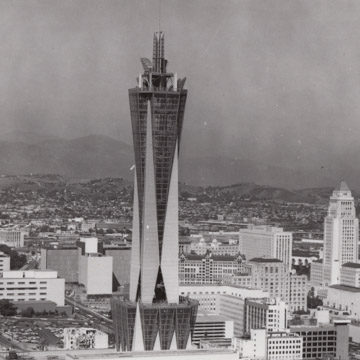AT&T Long Lines Madison Complex
The Madison Complex in Los Angeles is at once a typical example of postwar telephone buildings and an exceptional example of their embellishment with public art. The complex of three interconnected structures built as local and long-distance switching centers for Pacific Telephone and Telegraph and AT&T traces its roots on the site to a long-distance exchange building (Bliss and Faville) erected at 433 South Olive Street in the early 1920s. The modest nine-story commercial block, with Renaissance Revival details of brick and terra-cotta, housed operators, traffic engineers, and toll switching equipment. It was sited near Pershing Square in the heart of downtown, located near major clients including both city hall and the financial industry.
In 1948, a new building at 434 South Grand (Donald Parkinson) was erected directly behind the Olive Street building on a site that the telephone company originally bought in the 1920s to accommodate later expansion. The last of the three buildings is 420 South Grand (Woodford and Bernard), which went into service in 1961. It is directly adjacent to two earlier buildings, which connect through their rear elevations and basements. As is the case for many downtown telephone buildings, the location of subterranean switching equipment and wire conduits placed in the early twentieth century continued to root the aboveground infrastructure in a single unmovable location.
When expansion for additional lines and customers became necessary, the telephone companies used vertical expansion and adjacent real estate to build new floors and new buildings. The overall form of the 420 South Grand building was originally a squat, five-story block with three bands of ribbon windows only at one corner; by 1966, it expanded upwards an additional eight floors. The lack of visual coordination between the two buildings as they faced Grand Street was typical of telecommunications design by the 1960s, as only modest nods to cubic proportions and materials (an exterior cladding of cream-colored square aluminum tiles in this case) suggested a relationship between the buildings on their exteriors. 433 South Olive was then completely refaced to its existing appearance in 1971. The kind of architectural hodge-podge at the Madison complex, with awkward proportions and clashing visual styles, is typical of many urban telephone buildings across the country.
Together, the three buildings consolidated local and long-distance services for Pacific Bell and AT&T Long Lines. Pacific Bell also had additional infrastructure in buildings on the 700 block of South Olive Street, and the building of this complex three blocks north allowed the reorganization of AT&T and Pacific Bell’s interlocking long-distance and local telecommunications systems.
Decorative flourishes concentrate at the building’s top and at its base. The microwave tower that rose above the building’s roof provided enough height for the microwave horns to bounce signals unimpeded over the roofs of nearby buildings. Unlike the utilitarian microwave towers atop other long-distance buildings constructed during the same time period, the Madison Complex’s crystalline needle form, clad in shiny green glass and steel, gave the building a space-age feeling and drew attention away from the blank walls of the building’s facade—at least from a distance.
At ground level, a massive relief sculpture by Anthony Heinsbergen marks the main entrance on Grand Street. It continues the Art Deco tradition of celebrating operators, engineers, and telecommunications technology with its abstract visualization of networks connecting the continents. The pieces of the network are composed of actual switching equipment, including copper wire and step-by-step switches. The “weaver of speech,” a figure that traces its origins back to images of women telephone operators creating intricate patterns through connections of telephone wires, appears here as a nude male figure. The entire global scene gives the impression of a cutaway through the black granite revetment on the first floor, suggesting a metaphorical glimpse into the inner workings of the building itself. When originally installed, Australia was upside down, though it has now been upended.
In 1991–1992 Frank Stella installed a 40,000-square-foot mural at the rear of the Grand Street complex on the walls of the 433 South Olive building that wrap around the lower floors of 434 South Grand. The abstract mural titled Dusk (Moby Dick Series) further transformed the Madison Complex into an eclectic assemblage of architecture, technology, and art unrivaled in the city.
References
Bills, Emily. “The Telephone Shapes Los Angeles: Communications and Urban Form, 1880-1950.” PhD dissertation, New York University, 2005.
“Pacific Telephone Plans Record Expenditure in County Next Year.” Los Angeles Times, December 19, 1961.
SurveyLA and Daniel Prosser. “Los Angeles Citywide Historic Context Statement, Context: Public and Private Institutional Development, 1950-1980, Sub-Context: Communications, Theme: Telephone History and Development, 1881-1974.” City of Los Angeles Department of City Planning, April 2018.
Wallace, Robert K. Frank Stella’s Moby Dick: Words and Shapes. Ann Arbor: University of Michigan Press, 2000.
Writing Credits
If SAH Archipedia has been useful to you, please consider supporting it.
SAH Archipedia tells the story of the United States through its buildings, landscapes, and cities. This freely available resource empowers the public with authoritative knowledge that deepens their understanding and appreciation of the built environment. But the Society of Architectural Historians, which created SAH Archipedia with University of Virginia Press, needs your support to maintain the high-caliber research, writing, photography, cartography, editing, design, and programming that make SAH Archipedia a trusted online resource available to all who value the history of place, heritage tourism, and learning.










